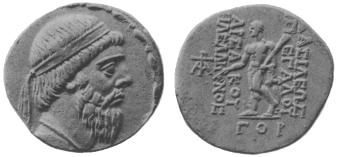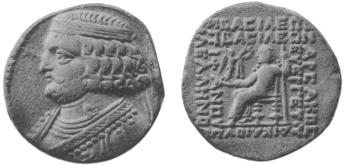


Parthia
[W. Wroth, B. M. C., Parthia, 1903 (with references to the works of Prokesch, Longpérier, Markoff, and, especially, P. Gardner’s Parthian Coinage, 1877); Ritter A. von Petrowicz, Arsaciden-Münzen, Wien, 1904 (a Catalogue of the Petrowicz Coll.). Cf. also A. de la Fuÿe in Rev. Num., 1904, p. 317; 1905, p. 129.]
»Parthia.com
The coinage of the Arsacid dynasty of the Parthian Empire covers
a period of more than 450 years, extending from the reign of Tiridates I, B.C. 248/47-211/10, to the reigns of Artabanus V and Artavasdes (circ. A.D. 224-228), under whom the rule of the Arsacids was subverted by Ardashir and the sceptre of Iran transferred to the dynasty of the Sassanidae (see under Persis, p. 824 n.). The coins are of silver and bronze, the former struck at first on the Attic standard, which was afterwards reduced, or, it may be, superseded by the Phoenician. The chief denomination is the drachm (67-58 grains). The tetradrachm (250-200 grains) is also common, especially from the time of Phraates IV onwards. The triobol, diobol, and obol are much rarer.
818
The types are mainly copied or adapted from those of Seleucid coins. The principal type (found, throughout, on the drachms) consists of
a Parthian warrior in mail-armour—probably the founder Arsaces—seated, at first on an omphalos, afterwards on a throne, and holding
a bow, the pride of the Parthian soldier. The immediate model was probably a silver coin of Antiochus I or II representing Apollo on the omphalos. On the later tetradrachms the usual type is a figure of
the Tyche of a Greek city (probably Seleuceia) presenting a diadem (wreath?) or palm-branch to the reigning king. The portrait-heads of
the obverse display, in many cases, a fair measure of artistic skill, as for instance those of Artabanus I, Orodes I, &c. (B. M. C., Parth., p. lxxiv f.: for the types of the bronze coinage see ib., pp. lxxi-lxxiv).
The legends are in Greek, which becomes almost unintelligible on the later drachms. From the time of Volagases I the king’s name is sometimes written in Pehlvi characters.
A minute study of the monograms and fabric and a careful record of finds and provenance are much needed to throw light on the obscure subject of Parthian mint-places (cf. B. M. C., Parth., pp. lxxviii ff.). The earlier coins must necessarily have been struck in Parthia Proper, i. e. in the country lying to the south-east of the Caspian, or in the neighbouring countries; but after the conquest, under Mithradates I, of Mesopotamia and of the provinces that had formed part of the Great Median Satrapy, new mint-places must have been established. It is probable that the
chief mint was at Seleuceia, the great Hellenic city on the west bank of
the Tigris, or at Ctesiphon, the neighbouring city or suburb, on the eastern side of the river and the capital of the Empire at least as early as the time of Orodes I. The names of the provinces ΜΑΡΓΙΑΝΗ and ΑΡΕΙΑ
are inscribed on drachms of Artabanus II(?); cf. ΤΡΑ[Ξ]ΙΑΝΗ and ΚΑΤΑΣΤΡΑΤΕΙΑ (B. M. C., p. 40).
The tetradrachms from the time of Phraates IV are regularly inscribed with the year and month of issue. The era is the Seleucid, beginning in the autumn of B.C. 312. The months are those of the Macedonian calendar, as follows:—Dios (= October?), Apellaeos, Audynaeos, Peritios, Dystros, Xandicos, Artemisios, Daesios, Panemos, Loös, Gorpiaeos, Hyperberetaeos, and Embolimos (the intercalary month).
The classification of the Arsacid coinage is far from certain, more especially in the period before Phraates IV, when the coins are, as a rule, undated, and only the dynastic name (‘Arsaces’) of each sovereign is recorded. Many difficulties also arise from our incomplete knowledge
of the history of Parthia (cf. Wroth, ‘Rearrangement of Parthian
Coinage,’ N. C., 1900, 181-202). The classification set forth below is
that proposed in the British Museum Catalogue.
| Arsaces the Founder. Circ. B.C. 250 - 211/210. |
No coins? |
| Tiridates I. B.C. 248/247 - B.C. 211-210.
Arsaces, son of Tiridates I. B.C. 210-191. |
ΑΡΣΑΚΟΥ. |
| ΒΑΣΙΛΕΩΣ ΑΡΣΑΚΟΥ. |
819
Phriapatius. B.C. 191-176.
Phraates I. B.C. 176-171 ? [1] |
ΒΑΣΙΛΕΩΣ ΜΕΓΑΛΟΥ ΑΡΣΑΚΟΥ. |
| ΒΑΣΙΛΕΩΣ ΘΕΟΥ ΑΡΣΑΚΟΥ. |
| ΒΑΣΙΛΕΩΣ ΜΕΓΑΛΟΥ ΑΡΣΑΚΟΥ ΘΕΟΠΑΤΟΡ(ος). |
| Period of Mithradates I. B.C. 171-138 ? [1] |
ΑΡΣΑΚΟΥ [ΑΥΤΟ]ΚΡΑΤΟΡΟ[Σ]. |
| ΒΑΣΙΛΕΩΣ ΜΕΓΑΛΟΥ ΑΡΣΑΚΟΥ. |
| ΒΑΣΙΛΕΩΣ ΑΡΣΑΚΟΥ ΦΙΛΕΛΛΗΝΟΣ. (Fig. 358.) |
| ΒΑΣΙΛΕΩΣ ΜΕΓΑΛΟΥ ΑΡΣΑΚΟΥ. |

FIG. 358.
| Phraates II. B.C. 138-128/127. |
ΒΑΣΙΛΕΩΣ ΑΡΣΑΚΟΥ. |
| ΒΑΣΙΛΕΩΣ ΜΕΓΑΛΟΥ ΑΡΣΑΚΟΥ ΘΕΟΠΑΤΟΡΟΣ. |
| Artabanus I. B.C. 128/127-123. |
ΒΑΣΙΛΕΩΣ ΑΡΣΑΚΟΥ. |
| ΒΑΣΙΛΕΩΣ ΜΕΓΑΛΟΥ ΑΡΣΑΚΟΥ ΘΕΟΠΑΤΟΡΟΣ. |
| ΒΑΣΙΛΕΩΣ ΜΕΓΑΛΟΥ ΑΡΣΑΚΟΥ ΦΙΛΑΔΕΛΦΟΥ. |
| ΒΑΣΙΛΕΩΣ ΜΕΓΑΛΟΥ ΑΡΣΑΚΟΥ ΦΙΛΑΔΕΛΦΟΥ ΦΙΛΕΛΛΗΝΟΣ. |
| Himerus ? B.C. 124-123. |
ΒΑΣΙΛΕΣΩΣ ΑΡΣΑΚΟΥ ΕΠΙΦΑΝΟΥΣ ΦΙΛΕΛΛΗΝΟΣ. |
| ΒΑΣΙΛΕΩΣ ΜΕΓΑΛΟΥ ΑΡΣΑΚΟΥ ΝΙΚΗΦΟΡΟΥ. |
| Mithradates II. B.C. 123-88. |
ΒΑΣΙΛΕΩΣ ΜΕΓΑΛΟΥ ΑΡΣΑΚΟΥ ΕΠΙΦΑΝΟΥΣ. |
| ΒΑΣΙΛΕΩΣ ΒΑΣΙΛΕΩΝ ΜΕΓΑΛΟΥ ΑΡΣΑΚΟΥ ΕΠΙΦΑΝΟΥΣ. |
| ΒΑΣΙΛΕΩΣ ΒΑΣΙΛΕΩΝ ΑΡΣΑΚΟΥ ΔΙΚΑΙΟΥ ΕΥΕΡΓΕΤΟΥ ΚΑΙ ΦΙΛΕΛΛΗΝ(ος). |
| Artabanus II. B.C. 88-77. |
ΒΑΣΙΛΕΩΣ ΜΕΓΑΛΟΥ ΑΡΣΑΚΟΥ ΘΕΟΠΑΤΟΡΟΣ ΕΥΕΡΓΕΤΟΥ ΕΠΙΦΑΝΟΥΣ ΦΙΛΕΛΛΗΝΟΣ. |
| ΒΑΣΙΛΕΩΣ ΜΕΓΑΛΟΥ ΑΡΣΑΚΟΥ ΘΕΟΠΑΤΟΡΟΣ ΕΥΕΡΓΕΤΟΥ. |
| Sinatruces. B.C. 77-70. |
ΒΑΣΙΛΕΩΣ ΜΕΓΑΛΟΥ ΑΡΣΑΚΟΥ ΑΥΤΟΚΡΑΤΟΡΟΣ ΦΙΛΟΠΑΤΟΡΟΣ ΕΠΙΦΑΝΟΥΣ ΦΙΛΕΛΛΗΝΟΣ. |
| Phraates III. B.C. 70-57. |
ΒΑΣΙΛΕΩΣ ΜΕΓΑΛΟΥ ΑΡΣΑΚΟΥ ΕΥΕΡΓΕΤΟΥ ΕΠΙΦΑΝΟΥΣ ΦΙΛΕΛΛΗΝΟΣ (also ΚΑΙ ΦΙΛΕΛΛΗΝΟΣ). |
| ΒΑΣΙΛΕΩΣ ΜΕΓΑΛΟΥ ΑΡΣΑΚΟΥ ΘΕΟΥ ΕΥΕΡΓΕΤΟΥ ΕΠΙΦΑΝΟΥΣ ΦΙΛΕΛΛΗΝΟΣ. |
| Phraates III? |
ΒΑΣΙΛΕΩΣ ΜΕΓΑΛΟΥ ΑΡΣΑΚΟΥ ΘΕΟΠΑΤΟΡΟΣ ΝΙΚΑΤΟΡΟΣ. |
| Phraates III or a contemporary ? |
ΒΑΣΙΛΕΩΣ ΜΕΓΑΛΟΥ ΑΡΣΑΚΟΥ ΕΥΕΡΓΕΤΟΥ ΕΠΙΦΑΝΟΥΣ ΦΙΛΕΛΛΗΝΟΣ. |
820
| Unknown King. Circ. B.C. 56. |
ΒΑΣΙΛΕΩΣ ΜΕΓΑΛΟΥ ΑΡΣΑΚΟΥ ΘΕΟΠΑΤΟΡΟΣ ΕΥΕΡΓΕΤΟΥ ΕΠΙΦΑΝΟΥΣ ΦΙΛΕΛΛΗΝΟΣ (also with ΚΑΙ ΦΙΛ). |
| ΒΑΣΙΛΕΩΣ ΜΕΓΑΛΟΥ ΑΡΣΑΚΟΥ ΦΙΛΟΠΑΤΟΡΟΣ ΕΥΕΡΓΕΤΟΥ ΕΠΙΦΑΝΟΥΣ ΦΙΛΕΛΛΗΝΟΣ (also ΚΑΙ ΦΙΛ). |
| Mithradates III. B.C. 57-54. |
ΒΑΣΙΛΕΩΣ ΜΕΓΑΛΟΥ ΑΡΣΑΚΟΥ ΔΙΚΑΙΟΥ ΕΠΙΦΑΝΟΥΣ ΘΕΟΥ ΕΥΠΑΤΟΡΟΣ ΦΙΛΕΛΛΗΝΟΣ (also with ΚΑΙ ΦΙΛ). |
| ΒΑΣΙΛΕΩΣ ΒΑΣΙΛΕΩΝ ΜΕΓΑΛΟΥ ΑΡΣΑΚΟΥ ΔΙΚΑΙΟΥ ΕΠΙΦΑΝΟΥΣ ΘΕΟΥ ΕΥΠΑΤΟΡΟΣ ΦΙΛΕΛΛΗΝΟΣ (also with ΚΑΙ ΦΙΛ). |
| ΒΑΣΙΛΕΥΟΝΤΟΣ ΒΑΣΙΛΕΩΝ ΑΡΣΑΚΟΥΟΣ (sic) ΕΥΠΑΤΟΡΟΣ ΔΙΚΑΙΟΥ ΕΠΙΦΑΝΟΥΣ ΚΑΙ ΦΙΛΕΛΛΗΝΟΣ. |
| ΒΑΣΙΛΕΩΣ ΒΑΣΙΛΕΩΝ ΑΡΣΑΚΟΥ ΛΙΟ·ΕΥΕΡΓΕΤΟΥ [Φ]ΡΑΑΤΟΥ ΕΠΙΦΑΝΟΥΣ ΕΠΙΚΑΛΟΥΜΕΝΟΥ ΦΙΛΕΛΛΗΝΟΣ ΓΟ[Σ?] (see B. M. C., p. 66 n.). |

FIG. 359.
| Orodes I. B.C. 57-38/37. |
ΒΑΣΙΛΕΩΣ ΒΑΣΙΛΕΩΝ ΜΕΓΑΛΟΥ ΑΡΣΑΚΟΥ ΚΑΙ ΚΤΙΣΤΟΥ. |
| ΒΑΣΙΛΕΩΣ ΒΑΣΙΛΕΩΝ ΑΡΣΑΚΟΥ ΦΙΛΟΠΑΤΟΡΟΣ ΔΙΚΑΙΟΥ ΕΠΙΦΑΝΟΥΣ ΦΙΛΕΛΛΗΝΟΣ (also with ΚΑΙ ΦΙΛ). |
| ΒΑΣΙΛΕΩΣ ΒΑΣΙΛΕΩΝ ΑΡΣΑΚΟΥ ΕΥΕΡΓΕΤΟΥ ΔΙΚΑΙΟΥ ΕΠΙΦΑΝΟΥΣ ΦΙΛΕΛΛΗΝΟΣ |
| ΒΑΣΙΛΕΩΣ ΒΑΣΙΛΕΩΝ ΑΡΣΑΚΟΥ ΔΙΚΑΙΟΥ. |
| ΒΑΣΙΛΕΩΣ ΒΑΣΙΛΕΩΝ ΑΡΣΑΚΟΥ ΥΡΩΔΟΥ. |
| Pacorus I. ob. B.C. 38. |
ΒΑΣΙΛΕΩΣ ΒΑΣΙΛΕΩΝ ΑΡΣΑΚΟΥ ΕΥΕΡΓΕΤΟΥ ΔΙΚΑΙΟΥ ΕΠΙΦΑΝΟΥΣ ΦΙΛΕΛΛΗΝΟΣ. |
| Phraates IV. B.C. 38/37-3/2. |
ΒΑΣΙΛΕΩΣ ΒΑΣΙΛΕΩΝ ΑΡΣΑΚΟΥ ΕΥΕΡΓΕΤΟΥ ΔΙΚΑΙΟΥ ΕΠΙΦΑΝΟΥΣ ΦΙΛΕΛΛΗΝΟΣ. |
| Tiridates II? B.C. 26. |
ΒΑΣΙΛΕΩΣ ΒΑΣΙΛΕΩΝ ΑΡΣΑΚΟΥ ΕΥΕΡΓΕΤΟΥ ΑΥΤΟΚΡΑΤΟ ΦΙΛΟΡΩΜΑΙΟ ΕΠΙΦΑΝΟΥΣ ΦΙΛΕΛΛΗΝΟΣ. |
| Phraataces (and Musa). B.C. 3/2-A.D. 4. |
ΒΑΣΙΛΕΩΣ ΒΑΣΙΛΕΩΝ ΑΡΣΑΚΟΥ ΕΥΕΡΓΕΤΟΥ ΔΙΚΑΙΟΥ ΕΠΙΦΑΝΟΥΣ ΦΙΛΕΛΛΗΝΟΣ. |
| ΒΑΣΙΛΕΩΣ ΒΑΣΙΛΕΩΝ. |
| ΘΕΑΣ ΟΥΡΑΝΙΑΣ ΜΟΥΣΗΣ ΒΑΣΙΛΙΣΣΗΣ. |
| Orodes II. A.D. 4 ? - A.D. 6 ? |
As Phraates IV. |
821
| Vonones I. A.D. 8/9-11/12. |
Obv. ΒΑΣΙΛΕΥΣ ΒΑΣΙΛΕΩΝ ΟΝΩΝΗΣ. |
| Rev. ΒΑΣΙΛΕΩΣ ΒΑΣΙΛΕΩΝ ΑΡΣΑΚΟΥ ΕΥΕΡΓΕΤΟΥ ΔΙΚΑΙΟΥ ΕΠΙΦΑΝΟΥΣ ΦΙΛΕΛΛΗΝΟΣ. |
| Obv. ΒΑΣΙΛΕΥΣ ΟΝΩΝΗΣ. |
| Rev. ΒΑΣΙΛΕΥΣ ΟΝΩΝΗΣ ΝΕΙΚΗΣΑΣ ΑΡΤΑΒΑΝΟΝ. |
| Artabanus III. A.D. 10/11 |
As Phraates IV. |
| ΒΑΣΙΛΕΩΣ ΒΑΣΙΛΕΩΝ ΕΥΕΡΓ ΕΤΟΥ ΑΡΣΑΚΟΥ. |
| ΒΑΣΙΛΕΩΣ ΑΡΣΑΚΟΥ ΔΙΚΑΙΟΥ ΕΠΙΦΑΝΟΥΣ. |
| Vardanes I. A.D. 41/42 - 45. |
As Phraates IV. |
| Gotarzes. A. D. 40/41 - 51. |
As Phraates IV. |
| ΒΑΣΙΛΕΩΣ ΒΑΣΙΛΕΩΝ ΦΙΛΕΛΛΗ ΕΠΙΦΑΝΟ ΔΙΚΑΙΟΥ ΕΥΕΡΓΕΤ ΓΩΤΑΡΖΟΥ. |
| ΒΑΣΙΛΕΩΣ ΒΑΣΙΛΕΩΝ ΑΡΣΑΚΟΥ ΥΟΣ ΚΕΚΑΛΟΥΜΕΝΟΣ ΑΡΤΑΒΑΝΟΥ ΓΩΤΕΡΖΗΣ (B. M. C., p. 165). |
| Vonones II. A.D. 51. |
No coins. |
| Volagases I. A.D. 51 - 77/78. |
ΒΑΣΙΛΕΩΣ ΒΑΣΙΛΕΩΝ ΑΡΣΑΚΟΥ ΕΥΕΡΓΕΤΟΥ ΔΙΚΑΙΟΥ ΕΠΙΦΑΝΟΥΣ ΦΙΛΕΛΛΗΝΟΣ. |
| Vol (Pehlvi inscr.). |
| Vardanes II. A.D. 55. |
ΒΑΣΙΛΕΩΣ ΒΑΣΙΛΕΩΝ ΑΡΣΑΚΟΥ ΕΥΕΡΓΕΤΟΥ ΔΙΚΑΙΟΥ ΕΠΙΦΑΝΟΥΣ ΦΙΛΕΛΛΗΝΟΣ. |
| Pacorus II. A.D. 77/78 - 109/110? |
ΒΑΣΙΛΕΩΣ ΒΑΣΙΛΕΩΝ ΑΡΣΑΚΟΥ ΠΑΚΟΡΟΥ ΔΙΚΑΙΟΥ ΕΠΙΦΑΝΟΥΣ Φ ΙΛΕΛΛΗΝΟΣ. |
| ΒΑΣΙΛΕΩΣ ΒΑΣΙΛΕΩΝ ΑΡΣΑΚΟΥ ΕΥΕΡΓΕΤΟΥ ΔΙΚΑΙΟΥ ΕΠΙΦΑΝΟΥΣ ΦΙΛΕΛΛΗΝΟΣ. |
| Pak (Pehlvi inscr.). |
| Artabanus IV. A.D. 80/81. |
ΒΑΣΙΛΕΩΣ ΒΑΣΙΛΕΩΝ ΑΡΣΑΚΟΥ ΑΡΤΑΒΑΝΟΥ ΔΙΚΑΙΟΥ ΕΠΙΦΑΝΟΥΣ ΦΙΛΕΛΛΗΝΟΣ. |
| Osroes. A.D. 106/107 (or 109/110)-130? |
ΒΑΣΙΛΕΩΣ ΒΑΣΙΛΕΩΝ ΑΡΣΑΚΟΥ ΕΥΕΡΓΕΤΟΥ ΔΙΚΑΙΟΥ ΕΠΙΦΑΝΟΥΣ ΦΙΛΕΛΛΗΝΟΣ. |
| Volagases II. A.D. 77/78 - 146/147. |
ΒΑΣΙΛΕΩΣ ΒΑΣΙΛΕΩΝ ΑΡΣΑΚΟΥ ΟΛΑΓΑΣΟΥ ΔΙΚΑΙΟΥ ΕΠΙΦΑΝΟΥΣ ΦΙΛΕΛΛΗΝΟΣ. |
| ΒΑΣΙΛΕΩΣ ΒΑΣΙΛΕΩΝ ΑΡΣΑΚΟΥ ΕΥΕΡΓΕΤΟΥ ΔΙΚΑΙΟΥ ΕΠΙΦΑΝΟΥΣ ΦΙΛΕΛΛΗΝΟΣ. |
| Mithradates IV. Circ. A.D. 130 - 147. |
ΒΑΣΙΛΕΩΣ ΒΑΣΙΛΕΩΝ ΑΡΣΑΚΟΥ ΕΥΕΡΓΕΤΟΥ ΔΙΚΑΙΟΥ ΕΠΙΦΑΝΟΥΣ ΦΙΛΕΛΛΗΝΟΣ. |
| Mitradata malka (Pehlvi) ΒΑΣΙΛΕΩΝ ΑΡΣΑΚΟΥ ΕΥΕΡΓΕΤΟΥ ΔΙΚΑΙΟΥ ΕΠΙΦΑΝΟΥΣ ΦΙΛΕΛΛΗΝΟΣ. |
| Volagases III. A.D. 147/148 - 191. |
ΒΑΣΙΛΕΩΣ ΒΑΣΙΛΕΩΝ ΑΡΣΑΚΟΥ ΟΛΑΓΑΣΟΥ ΔΙΚΑΙΟΥ ΕΠΙΦΑΝΟΥΣ ΦΙΛΕΛΛΗΝΟΣ. |
| Volgasi malka (Pehlvi) ΒΑΣΙΛΕΩΝ ΑΡΣΑΚΟΥ ΕΥΕΡΓΕΤΟΥ ΔΙΚΑΙΟΥ ΕΠΙΦΑΝΟΥΣ ΦΙΛΕΛΛΗΝΟΣ. |
| Volgasi Arsak malkin malka (Pehlvi inscr.). |
822
| Volagases IV. A.D. 191 - 207/208. |
ΒΑΣΙΛΕΩΣ ΒΑΣΙΛΕΩΝ ΑΡΣΑΚΟΥ ΟΛΑΓΑΣΟΥ ΔΙΚΑΙΟΥ ΕΠΙΦΑΝΟΥΣ ΦΙΛΕΛΛΗΝΟΣ. |
| Volgasi malka (Pehlvi) ΒΑΣΙΛΕΩΝ ΑΡΣΑΚΟΥ ΕΥΕΡΓΕΤΟΥ ΔΙΚΑΙΟΥ ΕΠΙΦΑΝΟΥΣ ΦΙΛΕΛΛΗΝΟΣ. |
| Volagases V. A.D. 207/208 - 221/222? |
Inscriptions as on coins of Volagases IV. |
| Artabanus V. Circ. 213-227. |
Hartabi malka (Pehlvi) ΒΑΣΙΛΕΩΝ ΑΡΣΑΚΟΥ ΕΥΕΡΓΕΤΟΥ ΔΙΚΑΙΟΥ ΕΠΙΦΑΝΟΥΣ ΦΙΛΕΛΛΗΝΟΣ. |
| Artavasdes. Circ. 227-228. |
Artavazi malka (Pehlvi) ΒΑΣΙΛΕΩΝ ΑΡΣΑΚΟΥ ΕΥΕΡΓΕΤΟΥ ΔΙΚΑΙΟΥ ΕΠΙΦΑΝΟΥΣ ΦΙΛΕΛΛΗΝΟΣ. |





